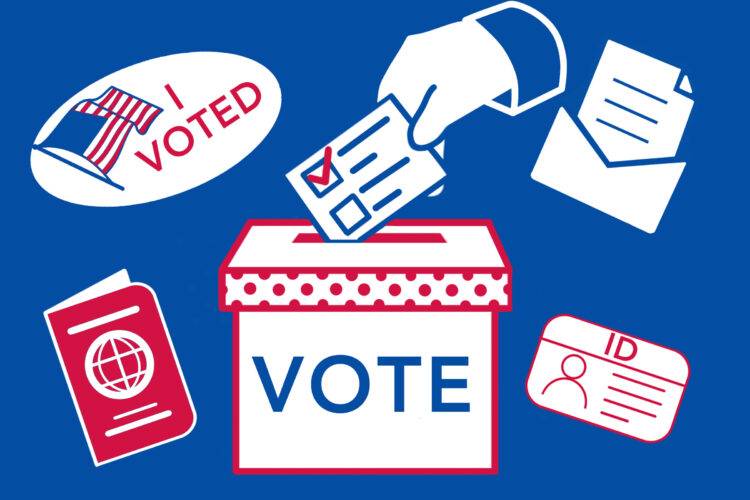Three in four American adults think that the 2024 presidential election is vital to the future of U.S. democracy,according to an Associated Press survey.
For many School of the Art Institute of Chicago students, Nov. 5, 2024 will be the first U.S. Presidential Election that they can vote in. Voting for elected officials is part of being an American citizen, but it also can be a process that is confusing to navigate, especially if you’ve never done it before.
As a college student from out of state, can you vote in Illinois?
By now, if you haven’t already voted, you’ve likely missed the mail-in deadlines for your home state (but you should always double check). That doesn’t mean you’ve lost your chance to vote in this election, because if you’re a domestic student, you can still vote right here in Chicago.
To be eligible to vote in Illinois there are a few criteria you have to meet. You have to be a U.S. citizen who has turned 18 on or before Nov. 5. Illinois voters have to live in their precinct for at least 30 days before the election, and since the Fall semester started in August, the majority of SAIC students will have met this requirement. You also must not be in prison, jail, or serving time for a conviction. However, Illinois allows citizens who have “been released from prison/jail and who meet all other requirements” to vote. Finally, you must not be voting elsewhere.
If you aren’t sure if you’re already registered, you can go to your state’s election website and look yourself up.
When do you vote?
The election will take place on Nov. 5, 2024. However, you can vote sooner than that.
Early voting downtown began on Oct 3, and by Oct. 21, all Chicago voting sites will have early voting. Any eligible voter can choose to vote early. If you have a crit on Nov. 5, you can consider voting beforehand.
On election day, the polls will be open from 6 a.m. to 7 p.m.
How do you register to vote in Illinois?
Illinois has a few different options to register to vote. If you did not register online by Oct. 20, you can do same-day voter registration and still be allowed to vote. You’ll need two forms of identification, at least one of which must have your Illinois address listed. Here are the accepted forms of ID for same-day voter registration:
- Passport or Military ID
- Driver’s License or State ID card
- College/University/School/Work ID
- Vehicle registration card
- Lease, mortgage, or deed to a home
- Credit or debit card
- Social Security, Medicare, or Medicaid card
- Insurance card
- Civic, union, or professional membership card
- LINK/Public Aid/Department of Human Services card
- Illinois FOID card
You can also use certain pieces of mail as one of your forms of ID to show your address, including bills, official transcripts from your school, bank statements, pay stubs, medical or insurance bills, or any official mail from a government agency.
Where do you go to vote?
Your polling location will change depending on your zip code. The Illinois government website allows you to enter your zip code and find out where your polling place is located.
For early voting, the two downtown locations are Supersite, 191 N. Clark Street, and the Board of Election Commissioners Office, 69 W. Washington Street.
If you have accessibility needs, voting locations are in one of three categories for how physically accessible and ADA-compliant each polling location is — low to no accessibility, medium accessibility, and high accessibility. Additionally, on election days, any protruding objects at polling locations will have “minimum temporary cand-detectable features” such as orange cones around them. Voters with questions about accessibility can email ADAaccess@chicagoelections.gov.
Besides the president, what are you voting for?
The president and vice president are the headliners on the ballet, but there are national, county, city, and judicial candidates to vote for as well. All 17 of Illinois seats in the U.S. House of Representatives will be on the ballot. This election cycle also includes the Cook County State’s Attorney, the Illinois Supreme Court, Appellate and Circuit Court Judges, and the Chicago Board of Education.
There are many guides online to help navigate what the different candidates do and what their campaign policies are. WTTV’s voter guide gives information about each of the positions that are up for election. There is local news coverage that gives context on each candidate, such as the Evanston Roundtable’s ballot guide. Progressive Illinois voters tend to like Stephanie Skorka’s “Girl, I Guess Voter Guide,” which informs at least 13 percent of Chicago voters. Conservative voters often use the iVoter Guide from the American Family Association.
Beyond candidates, the Illinois ballot also has three advisory ballot measure questions on each ballot. These are not legally binding laws to vote on; they give lawmakers information when they’re considering new policies.
Should I vote?
Ultimately, that is a choice you have to make. But voting is not a right that every citizen has always had in America, and often the margins between one candidate winning and the other losing are razor thin.





















